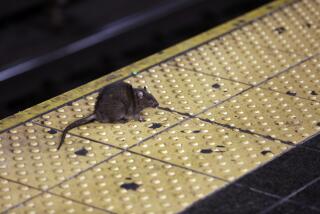Shuttle Rats Doomed by ‘Space Biology 101’ : NASA: Researchers hope to zero in on physiological changes caused by weightlessness alone, without the additional stresses of readapting to gravity.
- Share via
CAPE CANAVERAL, Fla. — Think of it as Space Biology 101.
Astronauts assigned to a shuttle laboratory mission this fall will use a guillotine to behead five or six rats in orbit. Then they will wield a scalpel, forceps and other surgical instruments to dissect the creatures.
It will be the first dissection of an animal in space, to NASA’s knowledge.
“These tissues, when they come back, are the biological equivalent of the moon rocks,” said NASA’s Willy Hinds, a biologist and immunologist who is in charge of the project.
Most everything will be removed from the decapitated rats and preserved by the astronauts for post-flight study: brain, eyes, inner ears, parts of the skull, spleen, heart, liver, kidneys, pancreas, thyroid, lungs, trachea, femurs, bone marrow, blood serum, aorta, pituitary gland, adrenal glands, quadriceps and other muscles, even testes.
The remaining rats aboard space shuttle Columbia--a record 48 will fly--will face a similar fate once they’re back on Earth.
None of the more than 100 rats that have flown before on NASA’s shuttles has lived longer than a few weeks upon return. They always have been killed after flight for dissection--in other words, after re-exposure to Earth’s gravity.
By having animals killed and dissected in space, researchers hope to zero in on physiological changes caused by weightlessness alone, without the additional stresses of readapting to gravity.
“That’s the big plus. That’s the first,” said Kenneth Souza, chief of the space life sciences payloads office at NASA’s Ames Research Center in Mountain View, Calif.
“It’s really a landmark that’s going to put in perspective the last 20 years” of in-depth rat research in space, said Danny Riley, acting chairman of the cellular biology and anatomy department at the Medical College of Wisconsin in Milwaukee.
Riley and other biologists have been waiting for this for years.
The rat dissections originally were scheduled for a late 1980s shuttle laboratory mission, a decade after scientists proposed the experiments to NASA. But the 1986 Challenger disaster disrupted everything.
There have been recent delays too.
The Spacelab flight by Columbia, until recently, was scheduled for September. It was bumped into October because of the numerous delays in getting Discovery off the ground; NASA will try again this week to launch Discovery, two months late.
The rat decapitations and dissections have been approved by the Animal Care and Use Committee at Ames, NASA’s center for animal research. Nonetheless, NASA is keeping a low profile to avoid outcry from animal-rights proponents. Several already have complained.
NASA insists that it uses as few animals as possible for experiments and tries to make the rats’ lives as comfortable as possible and their deaths whether in space or on the ground--as painless as possible.
“Beyond that, we believe in what we’re doing and we believe we’re doing it the right way,” said astronaut-physician M. Rhea Seddon, payload commander for the mission.
One of the many questions researchers hope to answer is whether space-induced changes in rats are similar to what happens in humans.
Riley said similarities already have been noted, at least post-flight, between rats and astronauts: muscle weakness, fatigue and poor coordination. Such symptoms could prove debilitating for humans after long space trips, thus the need for more study and development of countermeasures.
“We have to understand what’s happening at the cellular basis, and we can’t tell unless we use invasive procedures. That’s why we have to kill the animals,” Riley said.
Six experiments are planned with the Columbia rats, albino males that will be 2 to 3 months old on launch day.
Seddon and the three other astronauts assigned to Spacelab, including a veterinarian, will collect the feces of 12 rats to measure calcium content, draw blood from and inject radioactive isotopes into 15 other rats and inject a hormone that regulates red blood cell production into five of the 15.
The astronauts already have tested the guillotine, about the size of two thick phone books, aboard NASA planes that soar and then dive to provide brief bursts of weightlessness.
The guillotine is a typical laboratory model that NASA bought from a catalogue for about $100. A suction cup was attached so the guillotine sticks to a wall in the work station and doesn’t float around. Before dissecting the rats, the astronauts will use syringes to remove the blood that pools at the base of the severed necks.
“It’s a remarkably clean process,” Hinds said.






